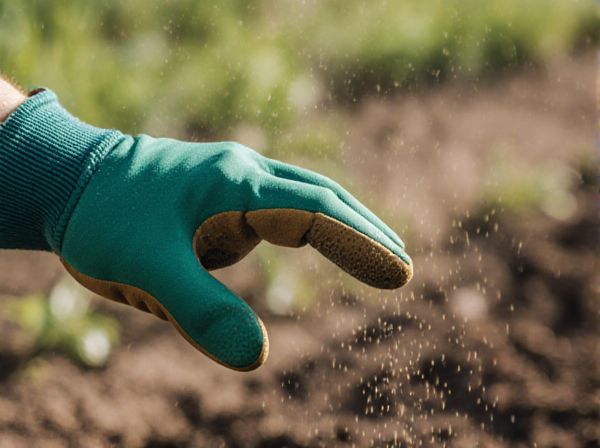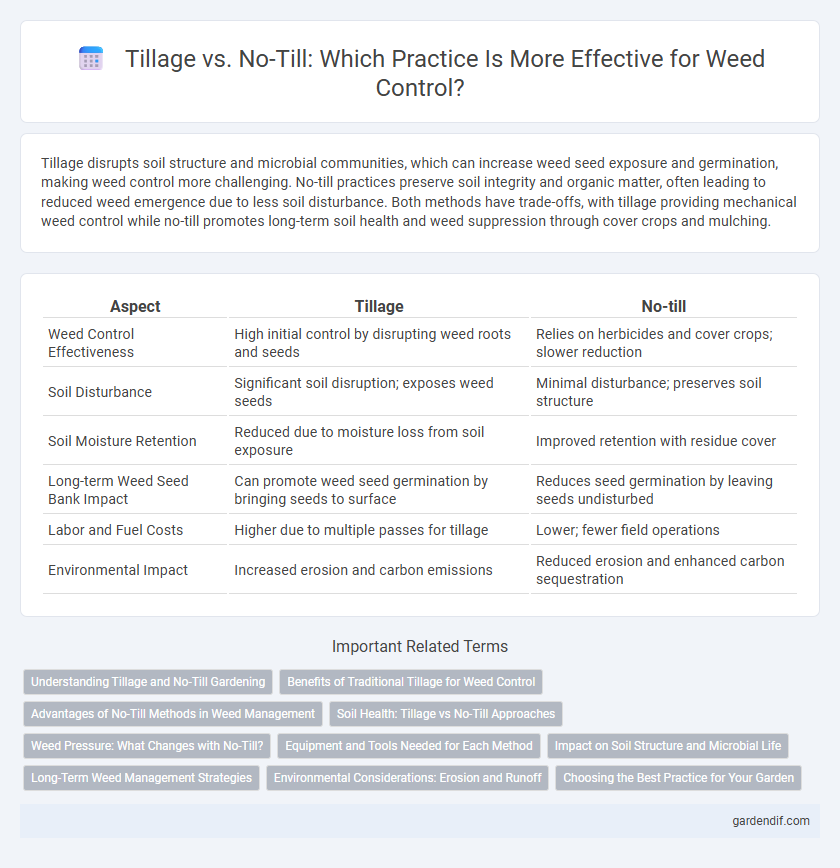
Tillage vs No-till Illustration
Tillage disrupts soil structure and microbial communities, which can increase weed seed exposure and germination, making weed control more challenging. No-till practices preserve soil integrity and organic matter, often leading to reduced weed emergence due to less soil disturbance. Both methods have trade-offs, with tillage providing mechanical weed control while no-till promotes long-term soil health and weed suppression through cover crops and mulching.
Table of Comparison
| Aspect | Tillage | No-till |
|---|---|---|
| Weed Control Effectiveness | High initial control by disrupting weed roots and seeds | Relies on herbicides and cover crops; slower reduction |
| Soil Disturbance | Significant soil disruption; exposes weed seeds | Minimal disturbance; preserves soil structure |
| Soil Moisture Retention | Reduced due to moisture loss from soil exposure | Improved retention with residue cover |
| Long-term Weed Seed Bank Impact | Can promote weed seed germination by bringing seeds to surface | Reduces seed germination by leaving seeds undisturbed |
| Labor and Fuel Costs | Higher due to multiple passes for tillage | Lower; fewer field operations |
| Environmental Impact | Increased erosion and carbon emissions | Reduced erosion and enhanced carbon sequestration |
Understanding Tillage and No-Till Gardening
Tillage involves mechanically turning the soil to disrupt weed growth and prepare seedbeds, promoting aeration and nutrient mixing but potentially leading to soil erosion and moisture loss. No-till gardening minimizes soil disturbance, preserving soil structure, enhancing microbial activity, and reducing weed seed exposure, which often results in fewer weeds over time. Choosing between tillage and no-till methods depends on soil health, weed pressure, and sustainable gardening goals.
Benefits of Traditional Tillage for Weed Control
Traditional tillage effectively disrupts weed seed banks by physically uprooting and burying seeds, reducing their germination potential. It enhances soil aeration and warmth, creating optimal conditions for crop growth while suppressing weed emergence. This method facilitates mechanical weed control, decreasing reliance on herbicides and promoting sustainable weed management.
Advantages of No-Till Methods in Weed Management
No-till methods reduce soil disturbance, minimizing weed seed germination and preserving beneficial soil microorganisms that suppress weed growth. This method fosters higher soil moisture retention, limiting conditions favorable for weed proliferation. By maintaining crop residues on the surface, no-till practices create a physical barrier that inhibits weed emergence and reduces reliance on herbicides.
Soil Health: Tillage vs No-Till Approaches
Tillage disrupts soil structure, leading to increased erosion, loss of organic matter, and reduced microbial activity, which negatively impacts soil health and weed suppression. No-till practices preserve soil integrity, enhance organic carbon retention, and promote beneficial microbial communities that compete with weeds naturally. Maintaining a diverse soil microbiome through no-till methods supports nutrient cycling and improves long-term soil fertility while minimizing weed emergence.
Weed Pressure: What Changes with No-Till?
No-till farming reduces soil disturbance, which often leads to increased weed seed persistence on the soil surface, resulting in higher weed pressure compared to tillage. The lack of mechanical disruption allows perennial weeds to establish deeper root systems, making them harder to control. Weed management in no-till systems typically relies more heavily on cover crops, mulches, and targeted herbicide applications to mitigate weed proliferation.
Equipment and Tools Needed for Each Method
Tillage requires plows, harrows, and cultivators to disrupt soil and remove weeds, enhancing seedbed preparation but increasing soil erosion risk. No-till farming utilizes specialized no-till seed drills and roller crimpers, minimizing soil disturbance while suppressing weed growth through residue cover. Both methods depend on precise equipment calibration to optimize weed control and maintain soil health.
Impact on Soil Structure and Microbial Life
Tillage disrupts soil structure by breaking down aggregates and exposing organic matter, leading to increased erosion and reduced moisture retention. No-till farming preserves soil integrity, maintaining porosity and aggregate stability that support diverse microbial communities essential for nutrient cycling. Maintaining undisturbed soil through no-till practices enhances microbial biomass and activity, promoting healthier, more resilient soils for sustainable weed management.
Long-Term Weed Management Strategies
Long-term weed management strategies in agriculture emphasize the benefits of no-till practices, as they reduce soil disturbance and limit weed seed germination compared to conventional tillage. No-till systems promote soil health, enhance microbial activity, and increase organic matter, which contribute to natural weed suppression over time. However, integrating crop rotation and cover crops remains essential to support these practices for sustainable weed control and reduce reliance on herbicides.
Environmental Considerations: Erosion and Runoff
No-till farming significantly reduces soil erosion by maintaining crop residue cover, which protects the soil surface from wind and water impact, thereby minimizing runoff. In contrast, tillage disturbs the soil structure, increasing vulnerability to erosion and enhancing sediment and nutrient runoff into nearby water bodies. The reduction in runoff associated with no-till practices also decreases the transport of herbicides and other agrochemicals, promoting better water quality and environmental sustainability.
Choosing the Best Practice for Your Garden
Tillage effectively disrupts weed growth by physically uprooting plants and exposing weed seeds to the surface, promoting germination and easier removal. No-till practices preserve soil structure and beneficial microbial communities, reducing erosion and long-term weed seed exposure, but may require integrated weed management strategies such as mulching or cover crops. Selecting the best practice depends on your garden's soil type, weed pressure, and sustainability goals, balancing immediate weed control with soil health preservation.
Tillage vs No-till Infographic

 gardendif.com
gardendif.com